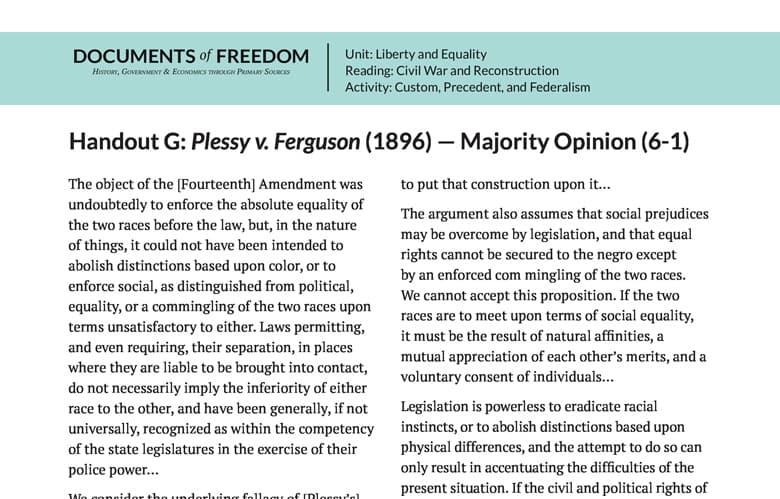Handout G: Plessy v. Ferguson (1896) — Majority Opinion (6-1)
Handout G: Plessy v. Ferguson (1896) — Majority Opinion (6-1)
The object of the [Fourteenth] Amendment was undoubtedly to enforce the absolute equality of the two races before the law, but, in the nature of things, it could not have been intended to abolish distinctions based upon color, or to enforce social, as distinguished from political, equality, or a commingling of the two races upon terms unsatisfactory to either. Laws permitting, and even requiring, their separation, in places where they are liable to be brought into contact, do not necessarily imply the inferiority of either race to the other, and have been generally, if not universally, recognized as within the competency of the state legislatures in the exercise of their police power…
We consider the underlying fallacy of [Plessy’s] argument to consist in the assumption that the enforced separation of the two races stamps the colored race with a badge of inferiority. If this be so, it is not by reason of anything found in the act, but solely because the colored race chooses to put that construction upon it…
The argument also assumes that social prejudices may be overcome by legislation, and that equal rights cannot be secured to the negro except by an enforced com mingling of the two races. We cannot accept this proposition. If the two races are to meet upon terms of social equality, it must be the result of natural affinities, a mutual appreciation of each other’s merits, and a voluntary consent of individuals…
Legislation is powerless to eradicate racial instincts, or to abolish distinctions based upon physical differences, and the attempt to do so can only result in accentuating the difficulties of the present situation. If the civil and political rights of both races be equal, one cannot be inferior to the other civilly or politically. If one race be inferior to the other socially, the constitution of the United States cannot put them upon the same plane.
Critical Thinking Questions
- What kinds of laws does the Court say that state legislatures have the rightful power to pass?
- What does the Court say is the basic flaw in Plessy’s argument?
- What does the Court argue about laws that try to abolish racial prejudices?
- Why is this decision said to have affirmed the doctrine of “separate but equal”?
